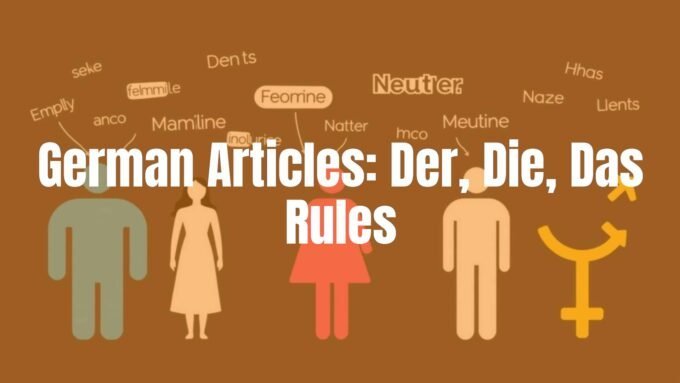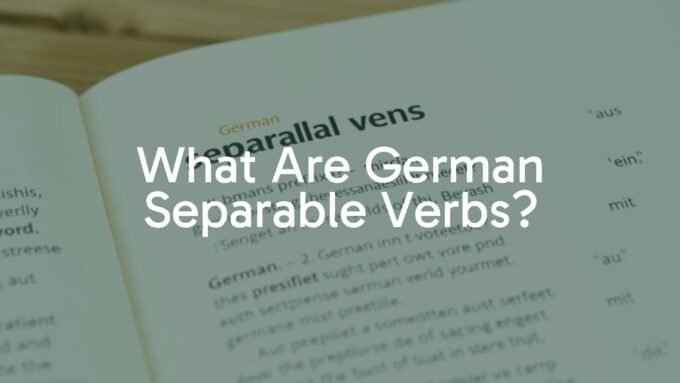German word order, or “Wortstellung,” is the set of rules for how words go together in a sentence so the meaning is clear. English mostly sticks to Subject-Verb-Object (SVO). German is more flexible, but not random. This freedom lets you add focus to different parts of a sentence, but you need to learn the core rules to do it well.
English is more analytic and relies on strict order because it lost many endings over time. German is an inflected language. It uses things like cases and endings to show how words relate to each other. This strong case system lets German move parts of the sentence around without losing clarity. That freedom makes German word order both interesting and, at times, confusing for learners used to English.
How does German word order compare to English?
The differences are clear. Both languages can use SVO for simple statements, but German branches off quickly. In English, moving words too much often sounds odd or wrong. Think of Yoda: “Him I can help.” You can understand it, but it is not standard English.
In German, such changes are common and often correct, and they add emphasis. “Ich sehe den Baum” (I see the tree) can also be “Den Baum sehe ich” with focus on “the tree.” English often uses stress in speech to highlight parts; German often uses word order. German’s endings and cases show who does what to whom, so the sentence can still make sense even if parts move.

Sentence structure in German: Key word order rules
To work with German sentences, learn a few basic rules about where to put the main parts. These rules give you a clear frame to build sentences. The main idea is the place of the verb and how it relates to the subject.
Make a clear difference between sentence structure (the frame) and word order (how you fill the frame). German is strict about where the conjugated verb goes, but many other parts can move. This mix of a fixed frame and a flexible order gives German its special style.
Subject, verb, and object: The core structure
At the basic level, German looks like English: Subject-Verb-Object. “Ich esse einen Apfel” (I eat an apple) follows SVO. The subject (Ich) comes first, then the conjugated verb (esse), then the object (einen Apfel).
But SVO is not a rule you can never break in German. It is the default for simple statements. Thanks to cases, other orders are possible. The subject is in the nominative case, so even if it does not come first, its role is clear. This clarity lets you move parts for focus.
The main verb position: What does ‘verb-second’ mean?
One of the most important rules in main clauses is “verb-second” (V2). The conjugated verb must be the second slot in the sentence. “Second” means second position, not necessarily the second word. The first position can be a single word, a phrase, or even a clause, as long as it acts as one unit.
Example: “Heute abend gehe ich ins Kino” (Tonight I’m going to the cinema). “Heute abend” fills the first position; “gehe” is second. Or: “Am Ende eines langen stressigen Tages trinkt Peter ein Bier” (At the end of a long stressful day, Peter drinks a beer). The long phrase sits in first position; “trinkt” is second. V2 is a core rule for main clauses.

Inversion: When does the subject come after the verb?
Inversion happens when the subject comes after the conjugated verb. This follows from the V2 rule. If something other than the subject stands in first position, the verb still must be second, so the subject moves after it. English does this rarely outside questions.
Example: “Heute komme ich” (Today I come). “Heute” is first, “komme” is second, and “ich” comes after the verb. Inversion lets you bring the first element into focus without changing the basic meaning.
The three primary German word order patterns
German word order can seem hard, but a few main patterns cover most cases. These patterns set where the finite verb and the subject go. Learn these, and you can handle the language’s flexible style.
Some sources list four patterns and include a “subordinate” pattern. We will cover the main clause patterns first and then treat subordinate clauses with their own rule set.
Pattern 1: Standard statements (declarative sentences)
In a simple statement, the subject goes first, the finite verb is second, and the rest follows. This fits both core ideas: the subject is near the verb, and the verb sits in second position.
Example: “Ich spiele Tischtennis” (I play table tennis). “Ich” is the subject, “spiele” is the finite verb in second position, and “Tischtennis” is the object. This is the neutral way to give information.
Pattern 2: Yes/no questions
Yes/no questions start with the finite verb. The verb comes first, then the subject, then other parts. This makes it clear that it is a question.
Examples: “Hast du Hunger?” (Are you hungry?) and “Kommt Peter aus Australien?” (Is Peter from Australia?). Here, the first position is the verb; nothing stands before it.
Pattern 3: Commands (imperatives)
Commands also use verb-first order. The finite verb (in the imperative form) comes at the start. The subject pronoun (like “du” or “ihr”) is usually dropped.
Examples: “Gib mir das Buch!” (Give me the book!) and “Sei still!” (Be quiet!). If you include a subject for emphasis, it follows the verb: “Bringe du mir das Buch!”
Pattern 4: Subordinate clauses (with subordinating conjunctions)
Subordinate clauses change the order: the finite verb goes to the end of the clause. This happens after subordinating conjunctions like dass, weil, wenn, obwohl or after a relative pronoun.
Examples: “Ich weiß, dass du das Buch gelesen hast” (…that you have read the book). The verb “hast” is at the end of the clause. “Ich bleibe zu Hause, wenn es regnet” (…when it rains). “Regnet” comes last in the clause. A whole subordinate clause can also fill the first position of a main clause: “Weil sie spannend sind, mag ich Action-Filme” (Because they are exciting, I like action movies).

Where do adverbs and other elements go in German sentences?
German sentences often include adverbs, auxiliary verbs, modal verbs, and separable verbs. Their places follow patterns that help the sentence sound natural. The order can move for focus, but there are common habits that make speech and writing clear.
Think less in terms of fixed rules and more in terms of common patterns and emphasis. You can shift parts to highlight them, as long as you keep the main frame.
Word order of adverbs: Time, manner, place (TMP rule)
When several adverbs appear, a useful order is Time-Manner-Place (TMP). In German: Zeit-Art-Platz (ZAP). Put time first, then how, then where.
Example: “Heute arbeite ich schnell zu Hause” (Today I work quickly at home). “Heute” (time), “schnell” (manner), “zu Hause” (place). You can move an adverbial to first position for focus, but keep V2: “Schnell arbeite ich heute zu Hause” puts the focus on speed.
If you stack time phrases, go from bigger to smaller: am Mittwoch um 18 Uhr (on Wednesday at 6 PM). In German, many adjectives also work as adverbs without adding “-ly.”
Word order with multiple verbs (auxiliaries, modal verbs, separable verbs)
With more than one verb, German often forms a “Satzklammer” (sentence bracket). The conjugated verb sits in second position; the other verb form (infinitive or participle) goes to the end of the clause, making a bracket around the middle parts.
With modal verbs (können, müssen, wollen) or auxiliaries (haben, sein, werden), the conjugated modal/auxiliary is second, and the main verb moves to the end: “Ich muss heute das Badezimmer putzen” and “Ich habe Fußball gespielt.”
Separable verbs (anrufen, aufstehen) split in main clauses: “Ich rufe dich heute an” (conjugated part in second; prefix at the end). With a modal or auxiliary, the separable verb stays together and moves to the end: “Ich will dich heute anrufen.”

How do conjunctions and clauses affect German word order?
Conjunctions shape word order by changing where the verb goes. The key difference is between coordinating and subordinating conjunctions. Relative clauses also follow their own pattern.
Joining clauses smoothly shows higher skill in German. These tools let you build longer sentences and express links between events and ideas.
Coordinating versus subordinating conjunctions
Coordinating conjunctions (und, aber, denn, oder, sondern) do not change word order in the clauses they connect. Each clause keeps its own main-clause structure with the verb in second position.
Example: “Ich spiele Tischtennis und ich mache Karate.” Both parts follow the normal pattern. Another: “Ich esse gern Salat, aber ich esse nicht gern Gemüse.”
Subordinating conjunctions (dass, weil, wenn, obwohl, bevor, nachdem) start a dependent clause and push the finite verb to the end of that clause.
Example: “Ich weiß, dass er hier ist” (…that he is here). “Ist” goes to the end of the subordinate clause.
| Type | Effect on word order | Common words | Example |
|---|---|---|---|
| Coordinating | No change; each clause keeps V2 | und, aber, oder, denn, sondern | Ich lese und ich schreibe. |
| Subordinating | Verb goes to the end of the clause | dass, weil, wenn, obwohl | Ich glaube, dass er kommt. |
Relative clauses and the verb-final rule
Relative clauses add extra information about a noun and also send the verb to the end. They start with a relative pronoun (der, die, das, welcher, welche, welches) that matches the noun’s gender and number, but its case depends on its role in the relative clause.
Examples: “Der Kaiser, der abdankte” (The emperor who abdicated). The verb “abdankte” comes last. “Das Haus, in dem ich wohne, ist sehr alt” (The house in which I live is very old). “Wohne” is at the end of the relative clause. The pronoun “dem” is dative because of “in” in that clause, and it is neuter singular to match “Haus.” Use commas to mark off relative clauses.
Common mistakes and helpful tips for mastering German word order
Learning German word order can feel like a maze. Many learners used to English find the flexibility both freeing and tricky. With steady practice and a clear grasp of a few rules, you can handle it well.
You do not need to memorize endless lists. Build a feel for patterns by listening and reading, and the logic will start to make sense.
Frequently confused word order scenarios
A very common mistake is mixing up main-clause V2 with verb-final in subordinate clauses. For example: “Ich weiß, dass er ist hier” is wrong. It should be “Ich weiß, dass er hier ist.”
Another common issue is with separable verbs and modal verbs. Learners forget to send the separable prefix or the infinitive to the end when a modal or auxiliary is present: “Ich will anrufen dich” should be “Ich will dich anrufen.” The placement of “nicht” can also be tricky because it can negate a single part or the whole clause, depending on where you put it.
The TMP rule is helpful, but if you move an adverbial to first position, remember to invert subject and verb. “Heute ich gehe ins Kino” is wrong; “Heute gehe ich ins Kino” is correct.
Quick strategies for remembering key rules
- Main clauses: keep the conjugated verb in second position. Treat the first position as one unit, not just one word. If something other than the subject goes first, invert subject and verb.
- Subordinate clauses: always move the finite verb to the end after a subordinating conjunction or a relative pronoun.
- Multiple verbs: think of the “Satzklammer” (verb bracket). The conjugated verb is second; the other verb form sits at the end.
- Emphasis: move the part you want to highlight to first position, but keep V2. Listen to native speakers and read often to see these patterns in action.
Practice German word order: Example sentences and exercises
Practice makes these patterns feel natural. Knowing the rules is the first step; using them in real sentences makes them stick. The V2 rule, verb-final clauses, and flexible adverb order become easier with repetition.
Try breaking down sentences to see the parts and why they sit where they do. Example: “Am Wochenende werde ich mit meinen Freunden ins Kino gehen.” Here, “Am Wochenende” is first position, “werde” (auxiliary) is second, “ich” is the subject, “mit meinen Freunden” is a dative phrase, “ins Kino” is place, and “gehen” (infinitive) sits at the end, forming the bracket.
Transform sentences to practice:
- Start: “Ich esse einen Apfel.“
- Yes/no question: “Isst du einen Apfel?“
- With a subordinating conjunction: “Ich weiß, dass du einen Apfel isst.“
- Time adverbial first: “Heute esse ich einen Apfel.“
- With a modal verb: “Ich will einen Apfel essen.“
You can also take a complex German sentence, translate it word-for-word into English to see how odd it sounds, then rewrite it as natural English. This shows why you should think in German patterns, not English ones.
Use online quizzes and sentence-building tasks for quick feedback. Making mistakes is normal and helpful. With steady practice and careful reading and listening, you will gain confidence and build clear, natural German sentences.













Leave a comment